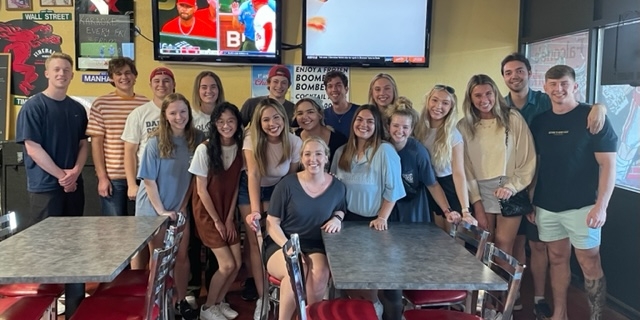Pallet sizes, stack heights and the location of items at Walmart’s distribution center in Pauls Valley, Oklahoma, may not be paramount in the minds of the store’s customers. But to company management, changes to these factors could mean six-figure savings annually, fewer employee injuries, improved employee satisfaction and, in some cases, more complete orders shipped out to customers.
These findings and more came from 36 students at the University of Oklahoma Price College of Business who gained real-world experience in supply chain management through an eight-week project with Walmart, the world’s largest retailer.
The project, which took place this spring semester, has been a staple of the capstone course, Supply Chain Management Strategies, for at least three years.
Five teams of students, all supply chain majors or minors, worked on five unique operational challenges facing the Walmart distribution center. These challenges included determining ideal pallet sizes for optimal productivity and reduced employee injury and identifying and adjusting specific processes to improve order fulfillment accuracy.
“It is exciting to see our students apply what they have learned from their various classes and use that knowledge to analyze and solve a problem,” said course instructor Sam Greco, a seasoned health care executive who has established supply chain management departments. “The need to be organized, accountable, inclusive and ultimately very prepared to make a presentation to a very senior manager is a great process to observe. They did a great job, and I could not be more proud.”
With Greco’s leadership and the guidance of an assigned Walmart distribution center manager for each team, the students observed operations; analyzed data; interacted with staff directly and through surveys; and brainstormed ideas, all with an eye toward providing recommended solutions to distribution center general manager Larry Turner.
During weekly check-ins, the teams provided project management and status reports to Greco and presented oral status updates to the class.
On May 2 in Price Hall, each team made a final presentation to Turner and two managers. The recommendations included solutions to the specific challenges and, collectively, would improve productivity and employee satisfaction; enhance employee safety; and reduce employee injury costs and employee turnover. If implemented, management also would see cost reductions and operating efficiencies, the students said.
Turner, the general manager, said the center looks forward to seeing the students’ presentations each semester.
“They are engaged throughout the process and outline a structured recommendation for correction,” he said. “Many times, they help us validate our thought process on a given problem.”
Lauren Starr, a Team 5 member, said the collaboration among teammates, their Walmart manager and their professor mimicked a real-life work situation.
“I think it is very important to have these experiences so one can refine and perfect these soft skills,” Starr said. “As I am about to enter the workforce, I am extremely grateful I got to practice my collaboration skills.”
Team 3 member Evan Rogers said, “It honestly felt like we were employed by Walmart and given a task to solve and fix to benefit the company. In other words, that is an experience that we all will for sure walk out with and be able to apply when we go into the workforce ourselves in the upcoming months.”
The SCM Strategy Teams were:
- Team 1: Melanie Door, Hunter Lane, Sam Paschal, Preston Smith, Sadie Johnson, Blake Lyon, Michael Barnes
- Team 2: Blake Winchester, Faith Ette, Xi Wang, Cameron Tharp, Amina Roska, Ismael Carmona Casado, Claire Vairin
- Team 3: Carter Baxter, Evans Rogers, Jacob Massad, Ryce Olson, Megan Clark, Truman Stein, Akshay Sunil
- Team 4: Jane Ray, Brynn Alford, Cassidy Mulligan, Grayson Logan, Dean Derebeew, Liz Burks, Ashley Seibert
- Team 5: Caroline Sem, Sidney Groves, Madison Young, Sherry Tran, Nicole Bourgeois, Robert Denney, Zachary Stancoff, Lauren Starr


